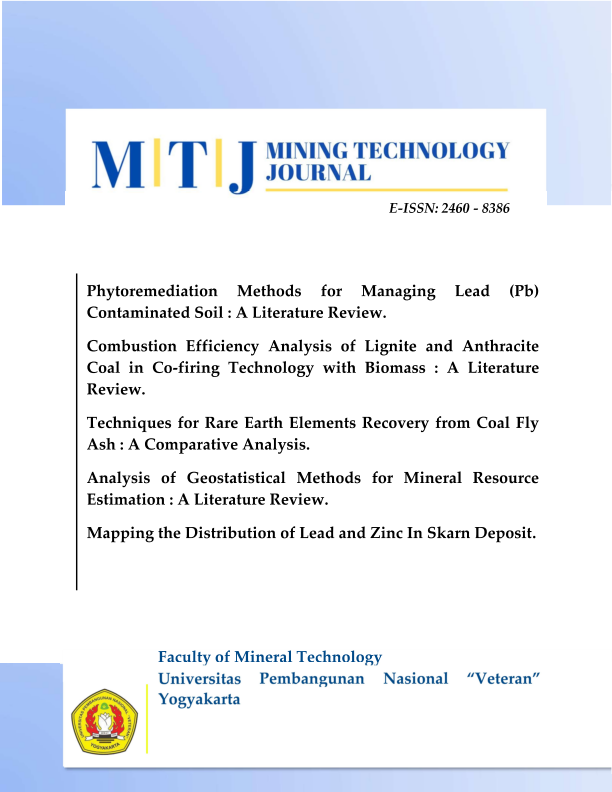COMBUSTION EFFICIENCY ANALYSIS OF LIGNITE AND ANTHRACITE COAL IN CO-FIRING TECHNOLOGY WITH BIOMASS: A LITERATURE REVIEW
DOI:
https://doi.org/10.31315/mtj.v2i2.13995Abstract
Coal is a non-renewable natural resource widely utilized as the main fuel for power generation, contributing approximately 80% of energy demand. However, dependence on coal presents significant challenges, such as future supply limitations, negative environmental impacts, and the need for diversification of energy sources. Co-firing technology, which involves the joint combustion of coal and biomass, is emerging as an alternative solution to improve combustion efficiency while reducing environmental impacts. This study aims to analyze the combustion efficiency of two types of coal, namely lignite and anthracite, combined with various types of biomass, such as sawdust, rice husk, wheat straw, tobacco, sawdust, and sunflower seed shells. Based on a literature review of previous studies, the analysis shows that lignite coal has higher combustion efficiency than anthracite when blended with biomass. The highest efficiency was recorded at 92% in the mixture of lignite with sunflower seed shells, supported by the reactive nature of lignite and the characteristics of biomass with high volatility and low ash content. In contrast, anthracite coal recorded its highest combustion efficiency of 85.5% when combined with sawdust biomass, attributed to the less reactive nature of anthracite and the high temperature required for complete combustion. Overall, co-firing technology has proven effective in improving combustion efficiency and utilizing biomass as a sustainable alternative fuel. The successful implementation of this technology highly depends on proper biomass selection, optimization of mixture proportions, and control of operating conditions. With a well-planned approach, co-firing can be a strategic solution to reduce greenhouse gas emissions while supporting the transition to a more efficient and environmentally friendly energy system.References
I. Aufi, J. Wintoko, & N. A. Masruroh, (2023). Evaluasi pemilihan teknologi Co-firing Biomassa pada PLTU batu bara dengan Metode Analytical Hierarchy Process (Studi Kasus: PLTU XYZ). Angkasa Jurnal Ilmiah Bidang Teknologi (Vol. 15, Issue 1, p. 88). https://doi.org/10.28989/angkasa.v15i1.1641.
Başar, C. A., Korkmaz, A. A., Önal, Y., & Utku, T. (2022). Evaluation of optimum carbonization conditions of the blended domestic polymeric waste, biomass and lignite in the presence of catalyst by Taguchi and ANOVA optimization analysis. Journal of Hazardous Materials Advances, 8, 100164. https://doi.org/10.1016/j.hazadv.2022.100164.
Creswell, J. W. (2014). Research Design: Qualitative, Quantitative, and Mixed Methods Approaches. SAGE Publications.
Ding, Y., Li, D., Zhang, X., Lv, M., Qin, S., Zhao, P., & Guo, C. (2024). Research on the co-combustion characteristics and kinetics of rice husk hydrochar with anthracite. Energy, 299, 131339. https://doi.org/10.1016/j.energy.2024.131339.
Hao, R., Zhang, Z., Zeng, Q., Mao, Y., He, H., Mao, X., ... & Zhao, Y. (2018). Synergistic behaviors of anthracite and dried sawdust sludge during their co-combustion: Conversion ratio, micromorphology variation and constituents evolutions. Energy, 153, 776-787. https://doi.org/10.1016/j.energy.2018.04.091.
Haq, S. R., Dewi, R. M., Erfiandri, L., Kasih, P. H., & Ardian, A. (2022). COVID-19 and coal industry in Indonesia: A preliminary analysis. Jurnal Mineral, Energi, dan Lingkungan, 5(2), 60-65. https://doi.org/10.31315/jmel.v5i2.6787.
Haykiri-Acma, H., & Yaman, S. (2009). Effect of biomass on burnouts of Turkish lignites during co-firing. Energy Conversion and Management, 50(9), 2422-2427. https://doi.org/10.1016/j.enconman.2009.05.026.
Li, X. G., Lv, Y., Ma, B. G., Jian, S. W., & Tan, H. B. (2011). Thermogravimetric investigation on co-combustion characteristics of tobacco residue and high-ash anthracite coal. Bioresource Technology, 102(20), 9783-9787. https://doi.org/10.1016/j.biortech.2011.07.117.
Liu, L., Memon, M. Z., Xie, Y., Gao, S., Guo, Y., Dong, J., ... & Ji, G. (2023). Recent advances of research in coal and biomass co-firing for electricity and heat generation. Circular Economy, 100063. https://doi.org/10.1016/j.cec.2023.100063.
M. Matei, O. Nedelcu, L. Matei, B. Soare, L. A. Matei, S. Mihaescu, C. Salisteanu, & I. Udroiu, (2010). Greenhouse gas emission reduction by biomass co-combustion with lignite. 2010 Conference Proceedings IPEC (p. 515). https://doi.org/10.1109/ipecon.2010.5697050.
Mohamed, A., Coşkun, T., & Ghareeb, A. (2024). Enhancing lignite coal quality with biomass waste in slow pyrolysis Fischer-Tropsch reactor. Journal of Engineering Research. https://doi.org/10.1016/j.jer.2024.06.020.
I. F. Nainggolan, H. Hadiyanto, & T. S. Utomo, (2023). Performance Analysis of Co-firing Using Palm Kernel Shells in Chain Grate Stoker Coal Fired Power Plant 2 x 7 MW. Briliant Jurnal Riset dan Konseptual (Vol. 8, Issue 2, p. 527). Universitas Nahdlatul Ulama Blitar. https://doi.org/10.28926/briliant.v8i2.1349.
Samudro, G. (2016). Konservasi Energi Berbasis Renewable Energy Technology dengan Pemanfaatan Teknologi Microbial. Jurnal Presipitasi Media Komunikasi dan Pengembangan Teknik Lingkungan (Vol. 13, Issue 2, p. 57). Diponegoro University. https://doi.org/10.14710/presipitasi.v13i2.57-65.
Setiawan, A. A. R., Munawar, S. S., Ishizaki, R., Putra, A. S., Ariesca, R., Sidiq, A. N., ... & Noguchi, R. (2024). Optimizing biomass supply for cofiring at power plants to minimize environmental impact: A case of oil palm empty fruit bunches in West Java. Fuel, 367, 131359. https://doi.org/10.1016/j.fuel.2024.131359.
Varol, M., Atimtay, A. T., Bay, B., & Olgun, H. (2010). Investigation of co-combustion characteristics of low quality lignite coals and biomass with thermogravimetric analysis. Thermochimica acta, 510(1-2), 195-201. https://doi.org/10.1016/j.tca.2010.07.014.
Ye, L., Zhang, J., Xu, R., Ning, X., Zhang, N., Wang, C., ... & Wang, C. (2022). Co-combustion kinetic analysis of biomass hydrochar and anthracite in blast furnace injection. Fuel, 316, 123299. https://doi.org/10.1016/j.fuel.2022.123299.
Yunianto, B., & Septiani, D. (2015). Peningkatan Efisiensi Kompor Gas dengan Penghemat Bahan Bakar Elektrolizer. In Rotasi (Vol. 17, Issue 1, p. 13). https://doi.org/10.14710/rotasi.17.1.13-18.
Zaman, M. R., & Suedy, S. W. A. (2020). Pemanfaatan Batubara Kalori Rendah pada IGCC (Integrated Gasification Combined Cycle). In M. R. Zaman & S. W. A. Suedy, Jurnal Energi Baru dan Terbarukan (Vol. 1, Issue 1, p. 35). https://doi.org/10.14710/jebt.2020.11156.
Downloads
Published
Issue
Section
License
Copyright (c) 2025 Mining Technology Journal

This work is licensed under a Creative Commons Attribution-NoDerivatives 4.0 International License.

